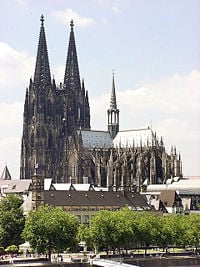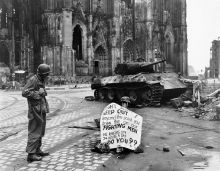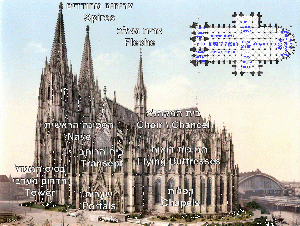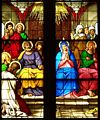Difference between revisions of "Cologne Cathedral" - New World Encyclopedia
David Doose (talk | contribs) |
David Doose (talk | contribs) m (→Modern events) |
||
| Line 106: | Line 106: | ||
==Modern events== | ==Modern events== | ||
As a World Heritage Site, and with its convenient position on tourist routes, Cologne Cathedral is a major tourist attraction, the visitors including many who travel there as a Christian pilgrimage. [[Image:koln cathedral wyd2005.jpg|thumb|[[World Youth Day 2005]]: there were nearly 1 million visitors.]] | As a World Heritage Site, and with its convenient position on tourist routes, Cologne Cathedral is a major tourist attraction, the visitors including many who travel there as a Christian pilgrimage. [[Image:koln cathedral wyd2005.jpg|thumb|[[World Youth Day 2005]]: there were nearly 1 million visitors.]] | ||
| − | |||
| − | |||
| − | |||
| − | |||
| − | |||
| + | On May 12, 2001, the American rock band [[R.E.M.]] performed a free concert in Roncalliplatz, the square to the south side of Cologne Cathedral. The concert was organised to promote the eradication of violence in schools, and was in part broadcast live on MTV Europe. | ||
| + | On August 18, 2005, [[Pope Benedict XVI]] visited the cathedral to participate in [[World Youth Day 2005]] festivities. An estimated 1 million people visited the cathedral during this time. Also as part of the events of World Youth Day, Cologne Cathedral hosted a [[TV|televised]] gala performance of [[Beethoven]]'s [[Missa Solemnis (Beethoven)|Missa Solemnis]], performed by the [[Royal Philharmonic Orchestra]] and the [[London Philharmonic Choir]] conducted by Sir [[Gilbert Levine]]. | ||
==Dimensions== | ==Dimensions== | ||
Revision as of 15:15, 29 July 2008
| Cologne Cathedral* | |
|---|---|
| UNESCO World Heritage Site | |

| |
| State Party | |
| Type | Cultural |
| Criteria | i, ii, iv |
| Reference | 292 |
| Region** | Europe and North America |
| Inscription history | |
| Inscription | 1996 (20th Session) |
| Endangered | 2004-2006 |
| * Name as inscribed on World Heritage List. ** Region as classified by UNESCO. | |
The Cologne Cathedral (German: Kölner Dom, officially Hohe Domkirche St. Peter und Maria) is the seat of the Archbishop of Cologne, under the administration of the Roman Catholic Church and is renowned as a monument of Christianity, of Gothic architecture and of the faith and perseverance of the people of the city in which it stands. Located beside the Rhine river it is dedicated to Saint Peter and the Blessed Virgin Mary.
Cologne Cathedral is one of the world's largest churches, being the largest Gothic church in Northern Europe. Even though it was started in 1248 it wasn't completed until 1880. For four years, 1880-84, it was the tallest structure in the world, until the completion of the Washington Monument followed by the Eiffel Tower. It has the second-tallest church spires with a height of 515 feet, only surpassed by the single spire of Ulm Cathedral, completed ten years later in 1890. Because of its enormous twin spires, it also presents the largest facade of any church in the world.
The Cathedral's main treasure is a golden reliquary containing the remains of the Three Magi of Christmas story fame. These relics and other treasures have made Cologne Cathedral a major pilgrimage destination for centuries.[1]
It was named a World Heritage Site in 1996, being one of the best-known architectural monuments in Germany, and Cologne's most famous landmark.
Background
In 1996, the cathedral was added to the UNESCO World Heritage List of culturally important sites. In 2004 it was placed on the "World Heritage in Danger" list due to nearby high-rise building and its visual impact upon the site, as the only Western site in danger. The cathedral was removed from the List of In Danger Sites in 2006, following the authorities' decision to limit the heights of buildings constructed near and around the cathedral.
The Cathedral was selected on the basis of cultural criteria and based on consideration of the fact that the monument has outstanding universal value as an exceptional work of human creative genius. It was also chosen because the more than six centuries it took to complete it serves as a powerful testimony to the strength and persistence of Christian belief in medieval and modern Europe.[2]
History
Ancient site
Before construction on Cologne Cathedral commenced in 1248 the site had been occupied by several previous structures. It stands on the site of a 4th century Roman temple, followed by a square church known as the "oldest cathedral" commissioned by Maternus, the first Christian bishop of Cologne. A second church built on the site, the "Old Cathedral," was completed in 818. This burned down on April 30, 1248.[3]
Medieval beginning
In 1164, the Archbishop of Cologne, Rainald of Dassel had acquired relics of the Three Kings which had been taken from Milan in Italy by the Holy Roman Emperor, Frederick Barbarossa. The relics had great religious significance and could be counted upon to draw pilgrims from all over Christendom. It was important that they were properly housed. The loss of the old five-aisled cathedral prompted a building program in the new style of Gothic architecture based in particular on the French Cathedral of Amiens.
The foundation stone was laid on August 15, 1248, by Archbishop Konrad von Hochstaden. The eastern arm was completed under the direction of Master Gerhard, was consecrated in 1322 and sealed off by a temporary wall so it could be in use as the work proceeded.
In the mid 14th century work on the west front commenced under Master Michael. This work halted in 1473 leaving the south tower complete up to the belfry level and crowned with a huge crane which was destined to remain in place, and the landmark of Cologne for 400 years.[4]
Some work proceeded intermittently on the structure of the nave between the west front and the eastern arm but during the 16th century, this ceased. [5]
19th century completion
With the nineteenth century romantic enthusiasm for the Middle Ages and spurred on by the discovery of the original plan for the facade, it was decided, with the commitment of the Prussian Court, to complete the cathedral. It was achieved by civic effort as the Central-Dombauverein, founded in 1842, raised two thirds of the enormous costs (over US$ 1 billion in today's money), while the Prussian state supplied the remaining third.
The construction restarted in 1842 using the original design of the surviving medieval plans and drawings, but utilizing more modern construction techniques including iron roof girders. The nave was completed and the towers were added.
The completion of Germany's largest cathedral was celebrated as a national event in 1880, 632 years after construction had begun. The celebration was attended by Emperor Wilhelm I.
World War II and post-war history
The cathedral suffered fourteen hits by aerial bombs during World War II but did not collapse and remained standing in an otherwise flattened city.
The repairs to the building were completed in 1956. In the northwest tower's base, an emergency repair carried out with bad-quality brick taken from a nearby war ruin remained visible until the late 1990s as a reminder of the War. Repair and maintenance work is almost constantly being carried out in some section of the building as wind, rain, and pollution slowly eat away at the stones.
On August 25, 2007, the cathedral received a new stained glass in the south transept window. With 113 square meters of glass, the window was created by the German artist Gerhard Richter. It is composed of 11,500 identically sized pieces of colored glass resembling pixels, randomly arranged by computer, which create a colorful "carpet." Since the loss of the original window in World War II, the space had been temporarily filled with plain glass.[6] The archbishop of the cathedral, Joachim Cardinal Meissner, who had preferred a figurative depiction of 20th-century Catholic martyrs for the window, did not attend the unveiling.[7]
Architecture
While the enormous Western facade is the largest in the world, the Cologne Cathedral has the world’s third largest church interior.
The design of Cologne Cathedral closely resembles that of Amiens Cathedral in terms of groundplan, style and the width to height proportion of the central nave. The plan is in the shape of a Latin Cross, as is usual with Gothic cathedrals. It has two aisles on either side, which help to support one of the highest Gothic vaults in the world, being nearly as tall as that of the Beauvais Cathedral. Externally the outward thrust of the vault is taken up by French-style flying buttresses. The eastern end has a single ambulatory, the second aisle leads into a chevet of seven radiating chapels.
Internally, the Medieval choir is more varied and less mechanical in its details than the 19th century building. It presents a French style arrangement of a very tall arcade, a delicate narrow triforium gallery lit by windows and with detailed tracery merging with that of the windows above. The clerestory windows are tall and retain some old figurative glass in the lower sections.
The whole is united by the tall shafts which sweep unbroken from floor to their capitals at the spring of the vault. The vault is of plain quadripartite arrangement.
The choir retains a great many of its original fittings, including the carved stalls. A 12.5 foot stone statue of Saint Christopher looks down towards the place where the earlier entrance to the cathedral was, before its completion in the late 19th century.
The nave is enhanced by many 19th century stained-glass windows including a set of five on the south side called the "Bayernfenster" which were a gift from Ludwig I of Bavaria, a set highly representative of the painterly German style of that era.
Treasures of Cologne Cathedral
The most celebrated work of art in the cathedral is the Shrine of the Three Kings, a large gilded sarcophagus dating from the 13th century, and the largest reliquary in the Western world. It is traditionally believed to hold the remains of the Three Wise Men's bones and 2,000-year-old clothes.
Near the sacristy is the Gero-Kreuz, a large crucifix carved in oak and with traces of paint and gilding. Believed to have been commissioned around 960 for Archbishop Gero, it is the oldest large crucifix north of the Alps and the earliest-known large free-standing Northern sculpture of the medieval period.[8]
In the Sacrament Chapel, is the Mailänder Madonna ("Milan Madonna"), dating from around 1290, a wooden sculpture depicting the Blessed Virgin Mary and the infant Jesus. The altar of the patron saints of Cologne with an altar piece by the International Gothic painter, Stephan Lochner is in the Marienkapelle ("St. Mary's Chapel"). Other outstanding works of art are to be found in the Cathedral Treasury.
Art
The interior of the Cathedral is a gallery of ancient art that includes the unusually large carved altar known as "Agilolphus". It was created around 1520 in Antwerp, then well known as the center of this craft. It focuses on the life and passion (i.e. torture) of Jesus, presented in three-dimensional carved scenes.
The choir benches (also called choir stalls) are works of art themselves, but they can only be viewed from the ambulatory (the passageway in back of the choir) through the railings. Carved from 1308 to 1311, the benches are still regarded as the most beautiful in Germany. With 104 total benches they form the largest existing set. Above the choir benches are large screens covered with a series of paintings. These are the oldest examples of the Cologne School of painting, created between 1332 to 1340.
Standing on small shelves richly decorated with colorful leaves are numerous statues, positioned at each pillar around the choir twenty feet above the floor. The statues represent Christ, the Virgin Mary, and the twelve apostles. They were made by the cathedral workshop at its height during the period of around 1270 — 1290. Above each statue are canopies upon which twelve angels stand, each holding a different musical instrument.
The clerestory windows in the choir of the Cologne Cathedral, with 10,170 ft. of glass surface, contain the largest series of stained glass windows still extant from the 14th century in Europe. The windows were completed before the choir stalls were installed in 1311. Ninety-five percent of the glass is original.[9]
Bells
The cathedral has eleven church bells, of which three are Medieval. The first was the 3.8-ton Dreikönigenglocke ("Bell of the Three Kings"), cast in 1418, installed in 1437, and recast in 1880. Two of the other bells, the Pretiosa (10.5 tons; at that time the largest bell in the Occident) and the Speciosa (5.6 tons) were installed in 1448 and remain in place today. The largest bell, the 24-ton St. Petersglocke ("Bell of St. Peter,"), was cast in 1922 and is the largest free-swinging bell in the world.[10][11]
Modern events
As a World Heritage Site, and with its convenient position on tourist routes, Cologne Cathedral is a major tourist attraction, the visitors including many who travel there as a Christian pilgrimage.
On May 12, 2001, the American rock band R.E.M. performed a free concert in Roncalliplatz, the square to the south side of Cologne Cathedral. The concert was organised to promote the eradication of violence in schools, and was in part broadcast live on MTV Europe.
On August 18, 2005, Pope Benedict XVI visited the cathedral to participate in World Youth Day 2005 festivities. An estimated 1 million people visited the cathedral during this time. Also as part of the events of World Youth Day, Cologne Cathedral hosted a televised gala performance of Beethoven's Missa Solemnis, performed by the Royal Philharmonic Orchestra and the London Philharmonic Choir conducted by Sir Gilbert Levine.
Dimensions
| External length | 144.58 m |
| External width | 86.25 m |
| Width of west façade | 61.54 m |
| Width of transept façade | 39.95 m |
| Width of nave (interior) | 45.19 m |
| Height of southern tower | 157.31 m |
| Height of northern tower | 157.38 m |
| Height of ridge turret | 109.00 m |
| Height of transept façades | 69.95 m |
| Height of roof ridge | 61.10 m |
| Inner height of nave | 43.35 m |
| Building area | 7,914 m² |
| Window surface area | 10,000 m² |
| Roof surface area | 12,000 m² |
| Interior volume | 407,000 m³ |
| Preceded by: Rouen Cathedral |
World's tallest structure 1880—1884 157.38 m |
Succeeded by: Washington Monument |
| Preceded by: Rouen Cathedral |
World's tallest building 1880—1890 |
Succeeded by: Ulm Cathedral |
Gallery
Detail of a window showing the patrons of the Cathedral, St. Peter and the Virgin Mary.
ReferencesISBN links support NWE through referral fees
- ↑ Cologne Cathedral (Kölner Dom) Sacred-destinations.com. Retrieved July 27, 2008.
- ↑ UNESCO World Heritage Sites, Cologne Cathedral
- ↑ Cologne Cathedral (Kölner Dom) Sacred-destinations.com. Retrieved July 28, 2008.
- ↑ Wim Swaan
- ↑ Wim Swaan gives the latest date as 1560, but a date of 1520 is considered more probable by other scholars.
- ↑ Gerhard Richter digitizes Cologne cathedral, Google translation from German to English, Original German article
- ↑ Fortini, Amanda, "Pixelated Stained Glass", The New York Times, 2007-12-09. Retrieved 2008-July-29.
- ↑ Howard Hibbard
- ↑ The Cathedral Interior Travelgermanyinenglish.com. Retrieved July 29, 2008.
- ↑ The World Peace Bell in Newport, Kentucky is larger, but turns around its center of gravity rather than swinging about its top.
- ↑ The Bells of Cologne Nme.com. Retrieved July 29, 2008.
Bibliography
- Harpur, James. 1994. The Atlas of Sacred Places: Meeting Points of Heaven and Earth. A Henry Holt reference book. New York: Henry Holt and Co. ISBN 0805027750
- Kaltwasser, Ute, Csaba Peter Rakoczy, and Michael Scuffil. 2002. Cologne Cathedral on Foot. Köln: Bachem. ISBN 3761616171
- Simson, Otto Georg von. 1988. The Gothic Cathedral: Origins of Gothic Architecture and the Medieval Concept of Order. Bollingen series, 48. Princeton: Princeton University Press. ISBN 0691099596
- Swaan, Wim. 1988. The Gothic Cathedral. London: Omega. ISBN 090785348X
- Wolff, Arnold. 1995. Cologne Cathedral: Its History : Its Works of Art. Koln: Grevne Verlag. ISBN 9783774303423
External links
- (English)(German) Cologne Cathedral Official website
- The Cathedral Interior
- Panoramic views
- Cologne Cathedral
- Cologne
- Cologne Cathedral and Pictures by GermanPlaces
- Cologne Cathedral
- Kipphoff, Petra. 2007. Coincidence and Illumination
- Essential Architecture
- Theobald, Hans-Wolfgang. The Organs in Cologne Cathedral—Their Conception and Function
- World Heritage
- Kölner Dom
- Cologne Cathedral in the Structurae database
- Cologne Cathedral at night from across the Rhine
| |||||||
Credits
New World Encyclopedia writers and editors rewrote and completed the Wikipedia article in accordance with New World Encyclopedia standards. This article abides by terms of the Creative Commons CC-by-sa 3.0 License (CC-by-sa), which may be used and disseminated with proper attribution. Credit is due under the terms of this license that can reference both the New World Encyclopedia contributors and the selfless volunteer contributors of the Wikimedia Foundation. To cite this article click here for a list of acceptable citing formats.The history of earlier contributions by wikipedians is accessible to researchers here:
The history of this article since it was imported to New World Encyclopedia:
Note: Some restrictions may apply to use of individual images which are separately licensed.

























